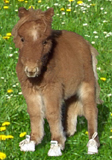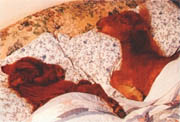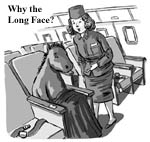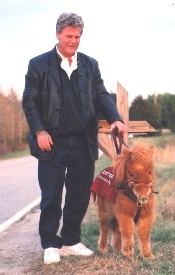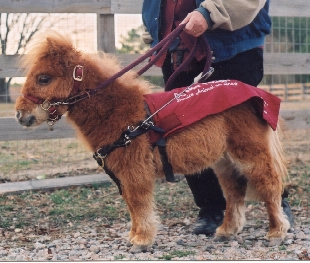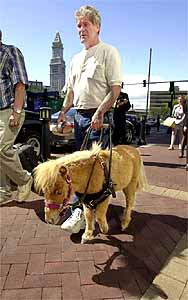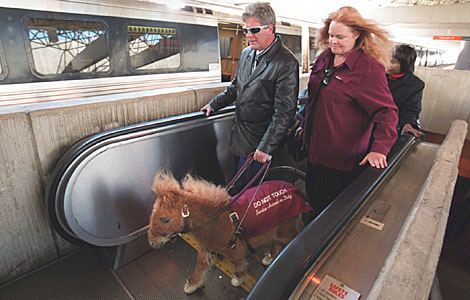| By
MATTHEW TEAGUE, Staff Writer
KITTRELL -- The scene
does seem a little absurd. Laughable, even. But
Janet Burleson keeps her jaw set, as she parades
around the back yard. Twinkie the miniature horse
leads her around various obstacles in the yard.
Twinkie is wearing a
little outfit, which seems appropriate for the
world's first guide horse. It's part harness, part
cape, and reads, "Service Animal In
Training." When she wears it, she is not to
eat, play or be petted.
Right now, Twinkie is
demonstrating her skills. She obeys Janet
Burleson's commands, and steers around the fence.
She's the first of her kind.
"Look at her,"
Janet's husband, Don, says proudly as he watches
from the patio. "Beautiful."
By day, the Burlesons are
mild-mannered computer specialists. In their off
time they train horses and plan to change the
world. Here is the upshot of what they propose:
Guide mini-horses will revolutionize the way blind
people get around.
Stranger things have
happened. Capuchin monkeys, for example, can
perform complex services for disabled people.
"They're very smart monkeys," said Julio
Marques, who researches animal intelligence at the
University of Illinois. "They can open doors,
bring you a drink, answer the phone.
Everything."
Then there was the famous
Guide Parrot in California. He would run from side
to side on his owner's shoulders, ringing tiny
bells to indicate in what direction to walk.
That's fine, you might
say. But when it comes to leading the blind,
what's wrong with the good old-fashioned German
shepherd?
For starters, both dogs
and horses cost about $25,000 to buy and train.
But dogs must retire after about 10 years, whereas
horses can put in 30. Also, horses have huge eyes,
on the sides of their heads, so they can see about
350 degrees -- a view that includes everything but
their own tails. Also, they don't get fleas, and
don't shed as much as a pooch.
Mini-horses are a little
more than 2 feet tall and can be kept by anyone
with a small yard. "Yeah," Don Burleson
says with a chuckle. "Good-bye lawn
mower."
|
 |
Staff
Photo By Robert MillerAndrew Burleson hands
the keys to his father, Don Burleson, as they
leave a training session for Twinkie at Crabtree
Valley Mall.
|
Don Burleson says the idea of guide mini-horses came to
him when a horse he was riding in New York City stopped on
its own accord at a red light. He now has four minis, and
regularly takes Twinkie to Crabtree Valley Mall for
training sessions. "Kids love her," he says.
Animal authorities were skeptical
but curious when they heard of Burleson's experiment. Most
thought it was a joke. Debbie Jackson works with the state
Division of Services for the Blind, and tried hard to get
her mind around the concept, but snickered just the same.
"Little ... horses ... right?" she said
Wednesday. "Well, now, that is intriguing."
She said the DSB would be
interested in hosting a demonstration by Twinkie.
Russell Post, head trainer for
Guiding Eyes -- perhaps the largest dog-training school in
the world -- said he would send a representative from New
York to see such a demonstration. "Oh, most
definitely," he said, when he figured out the
Burlesons were for real. "My receptionist told me
about it, and we've had some pretty bad jokes flying
around here."
Beyond the novelty of the idea,
Post said, guide mini-horses hold little promise. He gave
a long list of decisions guide dogs make moment to moment,
and challenged any horse to do the same. "I've never
known a horse that couldn't be spooked," Post said.
"And when you're standing in the middle of a
four-lane highway, there's a lot of spookiness. Also, dogs
can be house trained."
[http://www.guidehorse.com/footer.htm]
|
